Executive Summary
Recession is defined as a slump in economic activity in an economy over a considerably long period of time, or a cycle of business contraction. The great recession of 2007-2009 was the most profound and extensive economic slump ever experienced since the great depression of the early 20s and 30s.
The 2007/2009 recession is mainly attributed to the US subprime crisis. Even though reports on sub-prime crisis became public as early as 2007, its impact began to be felt in other parts of the world in 2008. The report will focus on the impact of this recession on the real estate market and how companies can survive it. The study will conduct a case study analysis of Savills PLC.
Introduction
Overview
The economic downturn is defined as a period of two or more successive quarters where there is a deep slump in the gross domestic product (GDP) (Gupta, 2009, p. 1). According to Gupta (2009, p. 2), the global output declined significantly in the 3rd quarter of 2007 and continued to drop in the 4th quarter.
In addition, energy prices increased and business growth slumped. The slump in business growth and increase in energy prices caused stagnation in pay increase and a rise in the cost of living respectively (Langlois, 2009, p. 1). Simpson (2009, p. 20) adds that recession is natural and unavoidable component of any market economy.
Classical economists documented that both monetary and real factors are involved in a series of boom and bus and that the causality runs in either direction (Simpson, 2009, p. 21). The most complete theory of the economic cycles was brought forward by Schumpeter.
Schumpeter believed that prosperity and recession was a price paid for growth in capitalist economy. He argued that improbability linked to human behavior means that things rarely turn out as expected. In other words, human beings normally suffer from cognitive prejudice when handling things (Clemence & Doody, 1950, p. 5).
Schumpeter paid special attention to specific sources of disturbances in a market economy, that is, confusions and disruptions caused by the introduction of new innovations. Innovations tend to turn up in bunches and their emergence not only result in a growth in investment but frequently set free a wave of absurd enthusiasm (Simpson, 2009, p. 21).
The great recession of 2007-2009 was the most profound and extensive economic slump ever experienced since the great depression of 1929-1932. Economic policy experts in the entire capitalist economies did not anticipate it. In fact, most of them denied it ever taking place and after it had happened they were not able to explain it. In addition, the mainstream economists, both Keynesian and neoclassical economists, did not see it coming (Parker, 2009, p. 8).
Report Purpose
The main focus of this paper will be on the great recession of 2007-2009 and how it impacted the United Kingdom’s real estate sector. The study will also explore ways through which the country’s real estate companies managed to survive the downturn. The study will be based on a case study analysis of the Savills PLC.
The impact of the recession
Impact on the global real estate sector
The phrase “credit crunch” became common in 2007 following the slump in the international money market. In order to comprehend impact of the 2007 crisis it is important to understand how it came about and what contributed to it. Economic experts attributed the credit crunch to the fall of the sub-prime mortgage market in the United States (Adair et al., 2009, p. 14). Even though reports on sub-prime crisis became public as early as 2007, its impact was not felt immediately.
In many EU countries the slump was originally assumed to be a United State’s problem. The impact of the crisis was already being felt all over the world. The US financial institutions were heavily criticized for their reckless loaning practice and for developing monetary tools that violated global monetary policies. The financing vehicles developed by the US financial institutions played a major role in the globalization of funds and real estate market (Adair et al., 2009, p. 15).
Before the subprime crisis the IMF and World Bank had expressed concern over the delicateness of numerous security products provided by the US and EU financial institutions. They felt that the borrowers were not taking the negative aspects of such products with the seriousness it deserves (Adair et al., 2009, p. 16).
The principal risk was the sharp decline in the prices of houses because securitization was based on supposition that any difficulty faced by the investors would be offset by growing property market. However, in the fourth quarter of 2007, it was apparent that the property market was also declining sharply.
As the value of property was plunging and the rate of defaulters increasing, the asset backed-securities attached to the US housing sector began to devalue at a high rate than was anticipated (International Monetary Fund, 2008, p.5). The slump in the US property market negatively affected the global balance sheet (International Monetary Fund, 2008, p.5).
According to Adair et al. (2009, p. 16), the drop in the value of residential property took away the incentive to pay back the mortgage, thus increasing the rate of the defaulters. The slump in the US property market robbed the international market of two important components namely: confidence and trust.
The financial institutions were exposed and had to suck up massive losses, though it was not clear which bank was most affected by then. The uncertainty increased mistrust among the financial institutions forcing them to stop lending funds to each other as they were unaware of each other’s financial statement.
As the banks and other financial institutions tried to switch and minimize risks their readiness and capability to give credit was held back, hence the tightening of fiscal and monetary policies. The availability of liquid assets in the global monetary market worsened in the 3rd quarter of 2008 when tow major financial and insurance companies were nearly collapsed.
The fall of Lehman Brother totally destroyed confidence in the monetary market. In addition, the fall of Lehman Brothers was enormously figurative, not just because of its position in the international monetary market but because it exposed the level of integration within the international banking system (Adair et al., 2009, p. 16).
Impact on the UK real estate
Before the global financial crisis, UK had witnessed a housing boom. Chronological analysis of the global financial crisis shows that where a recession is preceded by housing boom the recession tends to be more prolonged. Following an era of unparalleled growth in real estate many analysts had anticipated a downturn in the UK real estate market citing that the increase in the property values was untenable (International Monetary Fund, 2008, p.7).
Between 2009 and 2007 the average price of residential property in the UK grew by approximately £ 112000 depending on the index used. Figures piled up by Nationwide Monthly House Price Index shows an average figure of around £ 80000 towards the end of 1999 and £ 180000 at the end of 2007.
The Halifax price index reveals a figure of around £78000 towards the end of 1999 and £195000 towards the end of 2007. Even though these figures do not represent variations within the regional front, they highlight the fundamental trend within the national front before the recession (Adair et al., 2009, p. 33). The figure below shows the average prices of houses in UK from 1999 to 2007 as per the Nationwide and Halifax Index.
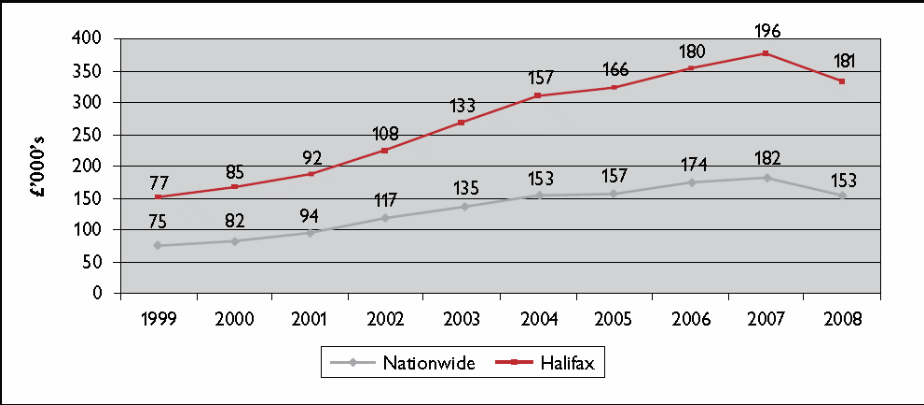
Source: Adair et al. (2009, p. 33)
The exceptional levels in the growth of residential property prices are attributed to low interest rates, high levels of employment, as well as demand for housing.
However, the principle reason for the increase in the levels of housing prices was availability of loan facilities. Since most financial institutions were striving to increase their demand in the mortgage market, they were prompted to relax their loan requirements. The wide range of mortgage products offered by the UK banks meant that credit was available to a wider population (Adair et al., 2009, p. 35).
During recession most of the real estate investors were left without income stream and specific walk out strategy. The impetus of the market was further thwarted by a sequence of growth in interest rate. The interest rate increase was an essential intercession to avert an increase in inflation caused by an increase in the international commodity prices.
The original increase in November 2006 had less impact on the growth of residential property price but the consecutive increments started to have an impact as the inflation rate started to remain stagnant before dropping to some level in the 3rd quarter of 2007 (see the figure below) (Adair et al., 2009, p. 35).
UK Average house price and percentage change
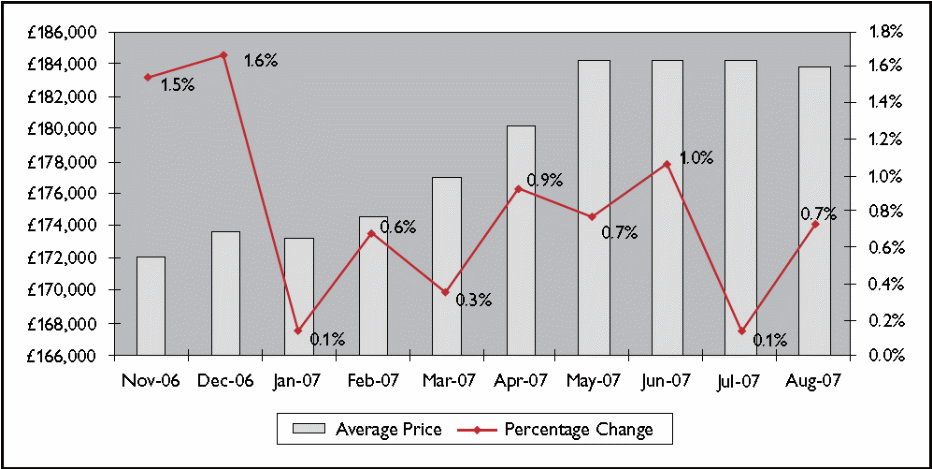
Source: Adair et al. (2009, p. 35)
The decline in August 2007 was considered as cyclic and certainly in September and October in the same year the prices of residential property continued to increase. According to the Nationwide Monthly House Price Index, the real estate market reached its climax in the late 2007 when the mean cost of residential property stood at £ 185000. However, according to the Halifax index, the climax was reached in the late 2007 when the mean residential property cost stood at £199 000 (Adair et al., 2009, p. 37).
A correction had been anticipated. However, the Interest rates were relatively low when measured up to the earlier recessions. The level of employment remained stable and the economy progressed, though at a slow pace (International Monetary Fund, 2008, p. 6). As the crisis deepened, its impact on both advanced and developing economies became intense.
The country fell into deep recession in the 3rd and 4th quarter of 2008. The recession allied with the drop in employment rate, job insecurity and tough lending conditions annihilated confidence in the UK residential property market. For this reason, the correction in the market was comparatively sharper than anticipated by many experts (International Monetary Fund, 2008, p.7).
According to the Nationwide Monthly House Price Index, the cost of the residential property in the country slumped for successive months from the late 2007 to the late next year. The prices had dropped from £184000 in November to £ 150000 in December 2008, representing an 18 percent drop.
Similarly, figures compiled by Halifax Price Index shows the same trend. The Halifax Price Index shows a drop from 184 700 in September 2007 to 153000 in December 2008. Even though it is not prudent to attach so much weight on these monthly figures, they give an indication of how severe the recession was (Adair et al., 2009, p. 38).
Case Study Analysis: Savills PLC
Savills PLC is a property consultancy firm based in London, United Kingdom. The company along with its auxiliaries provides business recommendations, consultancy services and management services through a broad network of bureaus across Europe, Asia, Africa and America.
Through its global network of more than 150 bureaus, the company provides a wide range of professional services to key sectors of the economy. The company’s vision is to provide consultancy service to individuals and companies seeking to purchase, manage, contract, construct or rent a prime residential and business property (Savills.com, 2013, p. 2).
Porters Five Forces Analysis of Savills PLC
This model is anchored on the comprehensive outlook on the company’s plans that meets the prospects and pressure within and without the industry. The five forces as identified by porters include: threats of new entrants, bargaining power of suppliers and customers, threat of substitutes, and the rivalry within the industry. Porter’s five forces analysis not only offers a significant foundation for strategic analysis but also examines the viability of the industry to come up with possible course of actions (Porter 1980, p. 3).
Savills PLC is a major player in the commercial property market both within and outside the UK. As a result, the Porter’s five forces have considerable impact on the company. Locally, the company is ranked among the top market leaders. However, over the recent past, Savills PLC has been faced with stiff competition from the local rivals and other news entrants. The ease of entry into a market dictates the level of competition.
The threat of entry significantly depends on the barriers put in place to ward off the new entrants (Porter 1980, p. 3). Barriers to entry in the UK commercial real estate market are low due to consolidation and the amount of capital required. According to Blockley and Godfrey (2000, p. 46), consolidation gives small businesses financial muscles to compete with the bigger rivals. In addition, the UK has Real Estate Investment Trust (REITS) which facilitates borrowing from local banks and regional banks.
The company’s main competitors in the real estate market are big national corporations and retail players. Some of these companies include: GVA Commercial Property Advisors, Capital and Centric PLC, MWB Group Holdings, London Metric Property, and Downing Developments among others (Savills, 2012, P. 7).
Customer’s bargaining power in the commercial real estate market is relatively low. This is due to the fact that most customers tend to be single households. A similar situation applies to the suppliers bargaining power. This is because the market is flooded with large numbers of small companies. Last but not least, threat to substitutes is also relatively low and is in the form of temporary shelters (Savills, 2012, P. 16).
Savills Financial trend
Income Statement in Great Britain Pound (£)
The company’s revenues increased by 11.77% (from 721.50m in 2008 to 806.40m 1n 2012) while net income grew 38.87% from 26.50m to 36.80m in the five year period. However, it should be noted that during 2008 and 2009 when the crisis hit the company, the growth in revenue was nearly stagnant. In addition, the income was negative in 2008.

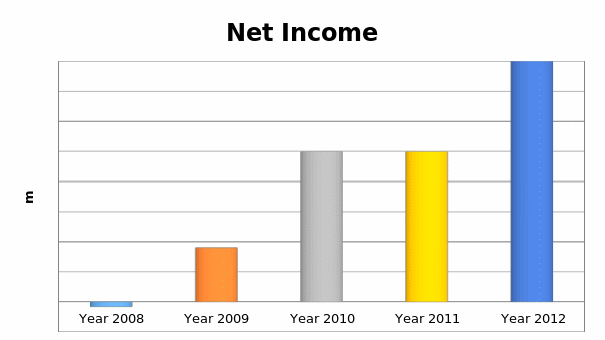
Gross Margin is zero
Net Margin is 4.1%
Operating Margin is 5.8%
Growth Rates in GBP
Dividend per share and Earning per share increased by 5.3 and 34.8 percent respectively within the five year period
Dividend yield (5 years average) was 0.03 percent
The dividend growth rate (5 years average) was -11.09 percent
The payout ratio was 35 percent
Earning per share growth (5 year average) was -8.6425
Cash Flow in GBP
In 2012, the company improved its cash reserves by 17 percent. It earned 59 million from from its activities for a margin of 7.3 percent.
Cash flow per share was 0.3
Price per cashflow per share was 17.1
Book value per share1.83
Tangible book value per share 0.661
Balance Sheet in GBP
The company to total capital ratio by December 2012 was 21.2 percent
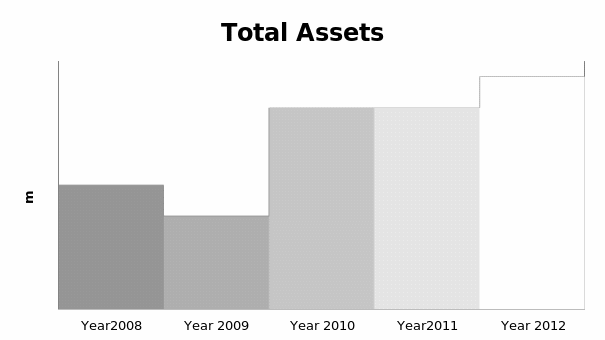
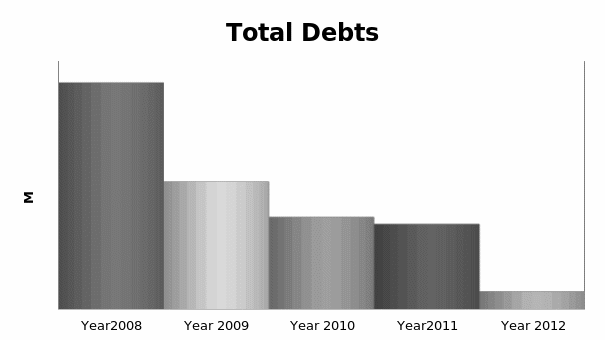
The current ratio for the five year period was 1.2. This is relatively positive since a current ratio of below one reflects the company’s inability to meet short-term obligations. Quick ratio for the five year period was 1.18. This is also positive for the company. Debt to equity ratio for the five year period was 0.2707, whereas debt to Capital ratio for the five year period was 0.2123. This shows a considerable level of leverage.
From all the above diagrams is very clear that the company considerably struggled during and after the recession, that is, between 2007- 2009 (even though 2007 is not captured in the graph). The crisis negatively affected the company’s revenue, cash flow and assets, which were at their all time low. Credit accessibility reflected by the company’s borrowing trend also declined after the recession. This may be partly attributed to the bank’s unwillingness to lend money or investors lack of confidence in the financial market.
Surviving the economic downturn
The most important aspect of any business survival is maintaining a positive relationship with all the clients. According to (Torrington Hall & Taylor, 2005, p. 12), organizational capital resources include: the relationship among people within the firm and between the firm and people outside the firm, and the firm’s organizational structure. It is not automatic that all the firm’s capital resources (physical, human and organizational) contribute to the firm achieving a competitive advantage.
Handy (2005, p. 67) recommend strategies that take the form of a continuous process of learning, in which at the frontier, preparation and execution becomes impossible to tell apart. He proposes that organizations should generate, develop and maintain excellent business designs capable of taking advantage of its strategic landscape and business environment beyond the lifetime series of changes in an organization.
This can only be achieved through a self-organizing process of the individual employees. Flood & Carson (1993, p. 24) acknowledges the role of strategic planning and the formation of networks since individual errors may have severe impact on the organization as a whole.
The company should also re-evaluate its risk management process. A number of literatures have highlighted the developments and challenges in the ongoing efforts to deal with risks (Jorion, 2012 p. 3; Figlewski & Levich, 2002, p. 3). Companies should set up platforms for risk minimization through policy and regulatory frameworks.
These platforms should be based on systems approach and modelling. Systems approach takes into account external and internal factors, system thinking and system theories. In addition, it requires action across various segments or professionals, wider collaboration and long-term investments. The company should also emphasize on the availability of capital and quality of the balance sheet.
According to Borrow (2009, p. 27), companies in the real estate market can enhance their performance through efficient cost management and attaining superior flexibility operation-wise. Gupta (2009, p. 76) explains that companies with a huge capital outlay should put priority on how to seize new opportunities, tackle risk investment portfolios and positioning themselves for expansion. However, companies with less capital should only focus on liquidity and cost reduction measures.
Conclusion
Recession is defined as a slump in economic activity in an economy over a considerably long period of time, or a cycle of business contraction. The great recession of 2007-2009 was the most profound and extensive economic slump ever experienced since the great depression of the early 20s and 30s.
The 2007/2009 recession is mainly attributed to the US subprime crisis. Even though reports on sub-prime crisis became public as early as 2007, its impact was not felt immediately. In the UK and the whole EU fraternity the profound effect of the crisis started to be felt in the 3rd quarter of 2008. The impact of recession was very hurting, especially in the property market. For this reason, the real estate companies must develop an economic survival guideline.
References
Adair, A, Berry, J, Haran, M, Lloyd, G & McCreal, S 2009, The Global Financial Crisis: Impact on Property Markets in the UK and Ireland, University of Ulster, Ulster.
Blockley, D & Godfrey, P 2000, Doing it Differently, Thomas Telford, London.
Clemence, RV & Doody FS 1950, The Schumpeterian System, Addison-Wesley Press, Cambridge, Mass.
Figlewski, S & Levich R M 2002, Risk Management; the State of the Art, Kluwer Academic Publishers.
Flood, RL & Carson, ER 1993, Dealing with Complexity, 2nd edn, Plenum Press, New York.
Gupta, U, 2009, Recession: causes, problems and effects, Abhishek Publications, New Delhi.
Handy C, 2005, Goods of Management, Arrow Books, London.
International Monetary Fund 2008, Global Financial Stability Report: Financial Stress and Deleveraging, Macro-Financial Implications and Policy, IMF Multimedia Services Division, Washington.
Jorion P 2001, Value at Risk, the new benchmark for managing financial risk, 2nd edn, McGraw-Hill.
Langlois, K 2009, What is recession, EAP, Duluth.
Parker, RE 2009, The Economics of the Great Depression: A Twenty First Century Look Back at the Economics of the Interwar Era, Edward Elgar Publishing.
Porter, M E1980, Competitive strategy: Techniques for analyzing industries and competitors, Free Press, New York.
Simpson, D 2009, Recession: Causes and Cures, Adam Smith Institute, UK.
Savills 2012, “Is the UK Housing Market becoming increasingly European”, Residential Property Focus Q3 2012.
Savills.com 2013, Savills PLC: About the company, https://www.savills.co.uk/
Torrington, D, Hall, L & Taylor, S 2005, Human Resources Management, 6th edn, Prentice Hall, Harlow.